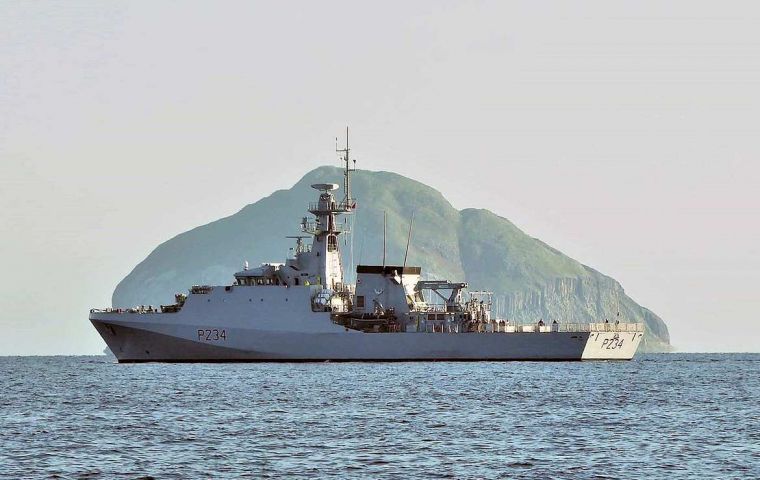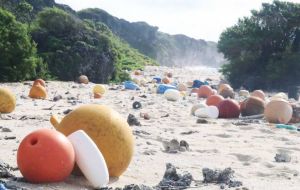MercoPress. South Atlantic News Agency
Who moved the island? For 85 years Henderson island has been in the “wrong place”
 Patrol ship HMS Spey confirmed the error as part of efforts to check and update charts of waters around British Overseas Territories scattered around the globe.
Patrol ship HMS Spey confirmed the error as part of efforts to check and update charts of waters around British Overseas Territories scattered around the globe.  Henderson is considered the most polluted island in the world as Pacific currents dump masses of plastic and rubbish along its beaches
Henderson is considered the most polluted island in the world as Pacific currents dump masses of plastic and rubbish along its beaches Sailors on a Royal Navy warship have proved a remote Pacific island has been in the 'wrong place' for 85 years. Henderson Island in the South Pacific is one mile south of the position marked on charts used by mariners the world over since 1937.
On the eve of British Science Week, patrol ship HMS Spey confirmed the error as part of efforts to check and update charts of waters around British Overseas Territories scattered around the globe.
Uninhabited and about the size of Oxford, Henderson is one of four islands in the remote Pitcairn chain. Chile lies 3,600 miles to the east and New Zealand 3,200 miles to the southwest.
The Royal Navy has been using navigational charts supplied by the UK Hydrographic Office, using the latest technology of the day, for more than 225 years.
Over the past 15 years, the majority of the Fleet has used digital charts. Key areas and seas regularly used are well covered by the electronic system which not only ensures pinpoint navigational accuracy, but allows sailors to ‘interrogate’ key features such as landmarks, buoys and depths, as well as turning specific features on/off as required.
The Pitcairn chain has only had some satellite-based data collection, which had already highlighted the inaccurate positioning on historical charts, so Spey offered to assist with data gathering.
She is not a dedicated survey vessel, but navigator Lieutenant Michael Royle used radar imagery gathered by Spey’s sensors and GPS positioning, overlaying the details on the existing charts of the Pitcairn chain.
“In theory, the image returned by the radar should sit exactly over the charted feature – in this case, Henderson Island,” Lieutenant Royle explained.
“I found that wasn’t the case – the radar overlay was a mile away from the island, which means that the island was plotted in the incorrect position when the chart was first produced. The notes on the chart say that it was produced in 1937 from aerial photography, which implies that the aircraft which took the photos was slightly off in its navigational calculations.”
The work by Spey is part of much wider government program to update maritime charts of waters around the UK’s Overseas Territories and improve navigation using sonar, airborne laser techniques and satellites to better understand, manage and protect the marine estates of these territories.
Henderson Island was last visited by the Royal Navy in late 2018 when HMS Montrose conducted an environmental survey to study the impact of plastics in the oceans.
Pacific currents dump masses of debris on the shoreline of the British Overseas Territory – an estimated 270 objects every day, with as many as 40 million items of plastic and rubbish scarring Henderson’s beaches, earning it the title ‘most polluted island in the world’.
![“Working directly with President [Donald] Trump and Congress, we accomplished what no one else could,” Patel stressed](/data/cache/noticias/108417/130x80/fbi.jpg)



Top Comments
Disclaimer & comment rulesCommenting for this story is now closed.
If you have a Facebook account, become a fan and comment on our Facebook Page!